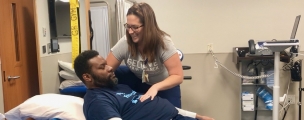In recent years, the treatment and prevention of breast cancer has become increasingly more sophisticated. But even with these new advances, many of these methods come with the risk of lymphedema, or swelling in the arm, chest or breast. There is no cure for lymphedema, but in this post, we’ll tell you about ways to reduce your risk and manage your symptoms.
What is lymphedema, exactly?
The lymphatic system transports fluid from the cells toward the heart. Through this system, toxic substances are removed from the body, and the reusable substances are returned to the blood circulation. When lymph nodes and vessels are removed, as they are during surgeries and other breast cancer treatments, it changes the flow of lymph fluid. This makes it difficult for the lymph fluid to leave that part of the body, causing a build-up of fluid and swelling.
In its early stages, there may be no visible swelling. Eventually, there is noticeable swelling, but early on, this will go away with elevation. In the later stages, there is visible swelling that does not go away. There may be a feeling of fullness in the arm, chest, breast or underarm area. Untreated lymphedema can become disfiguring with extreme thickening of the skin. Skin ulcers can occur that can also lead to infection.
If you notice swelling in your arm, seek medical attention. An early diagnosis and treatment improves the prognosis and limits disability.
How can I reduce my risk?
If you have had breast cancer with surgery or radiation, here are steps you can take to reduce your risk of developing lymphedema.
- Avoid trauma & infection. Trauma can cause additional swelling, as well as infection. Your body responds to infection by sending extra fluid and white blood cells to fight it. If lymph nodes and vessels are missing due to breast cancer treatment, it can cause lymphedema. Good hygiene and careful skin care can help you avoid infection, thereby reducing your risk of lymphedema.
- Keep your weight under control. Obesity is a major risk factor for developing lymphedema. After treatment, be sure to maintain a normal body weight.
- Avoid constriction. Constricting or squeezing the arm on your affected side may increase the pressure in nearby blood vessels, which could cause more swelling. Wear loose fitting clothing, and avoid shoulder straps on your purse or bags. If you have to fly, talk to your therapist about getting a compression sleeve to help prevent swelling.
- Exercise, but don’t overdo it. Using your muscles in your arms will help drain lymph fluid in your arms – but overuse can cause injury and has been linked to the start of lymphedema in some women. Be sure to talk with your therapist before beginning any exercise regimen.
How is it treated?
There are several ways to manage lymphedema. Magee’s Lymphedema Therapy Program at our Riverfront Outpatient Center utilizes Complete Decongestive Therapy, or CDT, for our lymphedema patients. This treatment consists of:
- Manual Lymph Drainage: This gentle and relaxing hands-on technique helps to cleanse the body of waste and toxins. In addition to relieving lymphedema symptoms, it also promotes healing. During this treatment, the therapist redirects the lymphatic circulation to decongest obstructed lymph vessels.
- Compression Bandaging: This treatment uses specialized bandages to increase pressure in the swollen arm to reduce swelling.
- Exercise: With the bandages in place, each muscle group and joint of the swollen limb is activated. This helps create a natural pumping effect to facilitate decongestion of the limb.
- Skin care: As individuals with lymphedema are at high risk for developing an infection, the Magee team teaches patients how to maintain meticulous skin care, hygiene and good nutrition.
Although lymphedema cannot be cured, it can be successfully managed, especially if caught early. To speak to someone in Magee’s Lymphedema Therapy Program, please call (215) 218-3900. For more information on lymphedema, check out this great resource from the American Cancer Society.







